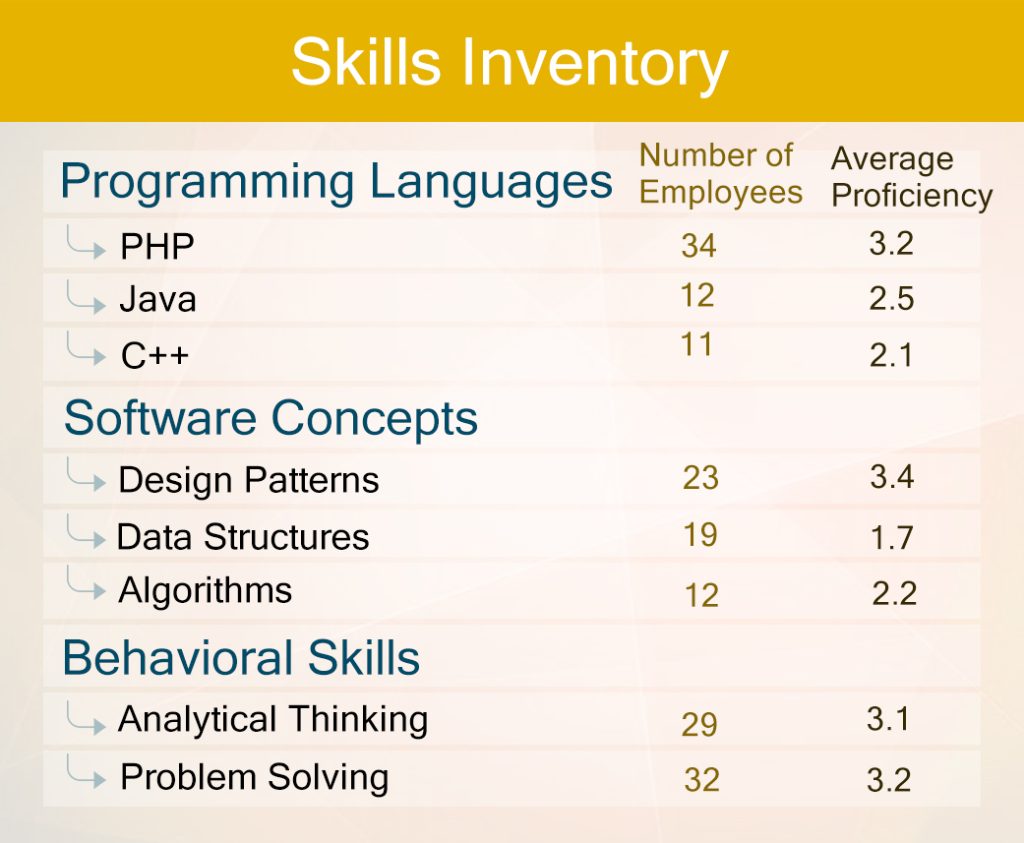An organization’s strength lies in the people that work there and the skills they hold.
Taking a skills-centered approach when managing your workforce will mean you can deploy the right personnel for a specific task, direct targeted training where it’s needed, and bring in the “right” people into your organization so that teams – and the organization as a whole – can work productively and efficiently.
Having a complete picture of skills informs key decisions
Organizations, and indeed countries, are set apart from each other on the basis of the skills they hold.
At the macro level, countries – particularly those with a predominantly service-based economy – are known for the skills of the people who live and work there. The United Kingdom, for example, is known for its banking sector. And the United States is known for its skills in developing new digital technologies. Companies naturally choose to locate to, or engage with, countries that are able to provide the right skills to meet their business needs.
At the micro level, an organization’s ability to beat the competition and respond to opportunities – as well as threats – relies on the skills it possesses within its workforce. But it’s not just as simple as having the skills; a company needs to be fully aware of those skills, have a true profile of them and be able to mobilize those skills quickly when needed.
In short, skills matter.
Skills are our true asset
The old adage “people are our true asset” is no longer right. The truth is that, in today’s world, skills are our true asset.
HR departments traditionally focus on the demographic information of staff or candidates and only identify high-level skills or qualifications of an individual. Too often, skills are categorized as broad brush job titles even though that may not really reflect what a person actually does day-to-day. A project manager, for example, will almost certainly mean different things in different organizations.
Drilling down to a more accurate understanding of skills is neglected, and this impacts on an organization’s ability to adapt to change. For example, without clear Skills Profiling, a large organization can’t easily identify and mobilize the right personnel who would be best to deal with a customer problem. Or, they don’t have the agility to quickly pull together a team with the right skills to bid for work or solve a problem under a tight deadline. What’s more, this approach misses the opportunity for targeted recruitment, or for an existing employee to identify targeted training to help them meet their personal development goals.
What are the goals of skills-centered human capital management?
- To identify and deploy skills quickly when a need is identified.
- To enable organizations to invest in targeted training to maximise return on investment.
- To make information on skills available to all to foster innovation, agility and collaboration.
What does a skills-centered organization look like?
- It uses a common language to describe skills. So, rather than people using different terminologies to describe similar competencies (like “internet marketing” and “web marketing”), everyone within the organization uses the same terminology.
- It puts skills information at the center of all HR systems and decisions, whether that be in relation to recruitment, learning and development, workforce management, project management or strategic planning.
- It creates detailed skills profiles for job roles and individuals so that it can map out “hard” technical skills, “soft” people skills, knowledge, domain, activities and qualifications, to help deliver personalized training and development of staff.
But why aren’t all organizations working this way?
A skills-centered approach is clearly good for business. It helps HR departments to work more efficiently, helps teams work more productively, and results in better job satisfaction for staff. So why aren’t all organizations working this way?
Simply put, without an intuitive technical solution, it’s easier not to.
It’s easier to track and analyze demographic information like age, education and job title instead of really understanding the skills profiles of the people those stats are meant to represent. It’s easier to group similar-sounding skills or job roles into umbrella terms rather than grappling with the subtleties that make them different. And it’s easier to stick with what we knew five years ago rather than keep up with the dynamic, changing skills of our workforce.
IYS will help you get skills-centered
We understand the fundamental challenges with classifying and categorizing skills. And we’ve worked hard to create a technical solution that will help your organization get skills-centered.
Our Skills and Occupation Taxonomy (ISOT) enables you to truly understand the skills of your workforce. The ISOT is a comprehensive and intelligent database of skills which maps out the complex relationships between skills. We’ll work with you to enhance the ISOT to tailor it to your specific company, based on your products, services or processes, and to create Skills Profiles so you can comprehensively map the skills of your people and job roles.
We’ve built three Skills Management applications, to put you in control. The Organization Skills Management, Employee Skills Management and Recruitment Skills Management applications keep skills at the center, so you can see the complete picture of your organization’s biggest asset: your skills.





